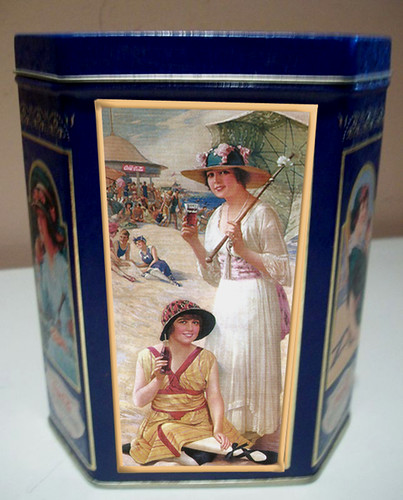Fashioning Performance
Marilyn Slater may be correct when she notes that Mabel’s start in modeling – rather than theatre -- gave her the advantage of not having to “unlearn” stage mannerisms (and her stage efforts later in her career were minimal and unsuccessful). But I think of equal importance is the kind of modeling assignments with which she began her career, and the contexts of modeling itself at the time. Firstly, Mabel entered modeling around the age of 17 working for a variety of artists – Hamilton King, James Montgomery Flagg, Charles Dana Gibson – for a range of contexts: advertising images for a variety of commercial goods, not simply clothing for example see Coke calendar (Sherman 10-11), as well as magazine covers and illustrations, postcards. William Thomas Sherman (Mabel Normand Source Book), much like Marilyn Slater, sees great value in this to her film performance style learning specific poses and gestures for particular scenes (11). However, where I think this becomes less useful is in seeing her understatement -- supposedly learned from posing -- as attached to a form of realism, which I would argue is actually quite counter to her performance style. Moreover, I would argue, we need to read her performance style as related to the context of modeling at this time. Firstly, as Mabel points out, these were cross commercial contexts where the models were employed, not high fashion (Sherman 10). Moreover, while there were department stores that featured fashion shows, high fashion models were rare. Rather the shows were designed for wide ranging demographics (department stores and catalogues brought ready made to wear to many homes crossing class and regional differences). Secondly, even until the late 1920s and 30s much clothes/fashion modeling was done interestingly enough not via photography but mainly through illustration (Farrell-Beck and Parsons 11-12). Illustration – even with skilled detail – is s distinct visual style that is at least once removed from realistic representation, an evocative holding of the world at a distance for a moment of openness, interpretation, and possibility.

Moreover, Mabel’s perhaps most well-known modeling association was with Charles Dana Gibson – and it is the Gibson Girl, who provides more context for the era. Firstly, the Gibson Girl was known for her athleticism, intelligence, and “cool detachment” (Gordon 211). Physical activity, vigor, and fearless -- alongside clothes that matched this lifestyle (less restrictive) – were all key components to the Gibson Girl’s identity. At the same time, it is important to remember that this “girl” was distinctly between the past worlds of Victorianism and the flapper, and while perhaps more free in dress, movement, and manners than her predecessor, hardly radical. Lynn D. Gordon’s article on the Gibson Girl notes that she was considered a quite conservative figure and as these “types” entered colleges their appearance helped to make higher education more acceptable to those worried about the institutions negative effect on “femininity” (214-215). The Gibson Girl as model, who isn’t “posing” but modeling, moving, trying on and discarding multiple possibilities for the “modern woman” and all with equal plausibility (or implausibility).

Moreover, Mabel’s perhaps most well-known modeling association was with Charles Dana Gibson – and it is the Gibson Girl, who provides more context for the era. Firstly, the Gibson Girl was known for her athleticism, intelligence, and “cool detachment” (Gordon 211). Physical activity, vigor, and fearless -- alongside clothes that matched this lifestyle (less restrictive) – were all key components to the Gibson Girl’s identity. At the same time, it is important to remember that this “girl” was distinctly between the past worlds of Victorianism and the flapper, and while perhaps more free in dress, movement, and manners than her predecessor, hardly radical. Lynn D. Gordon’s article on the Gibson Girl notes that she was considered a quite conservative figure and as these “types” entered colleges their appearance helped to make higher education more acceptable to those worried about the institutions negative effect on “femininity” (214-215). The Gibson Girl as model, who isn’t “posing” but modeling, moving, trying on and discarding multiple possibilities for the “modern woman” and all with equal plausibility (or implausibility).
Discussion of "Fashioning Performance"
Add your voice to this discussion.
Checking your signed in status ...